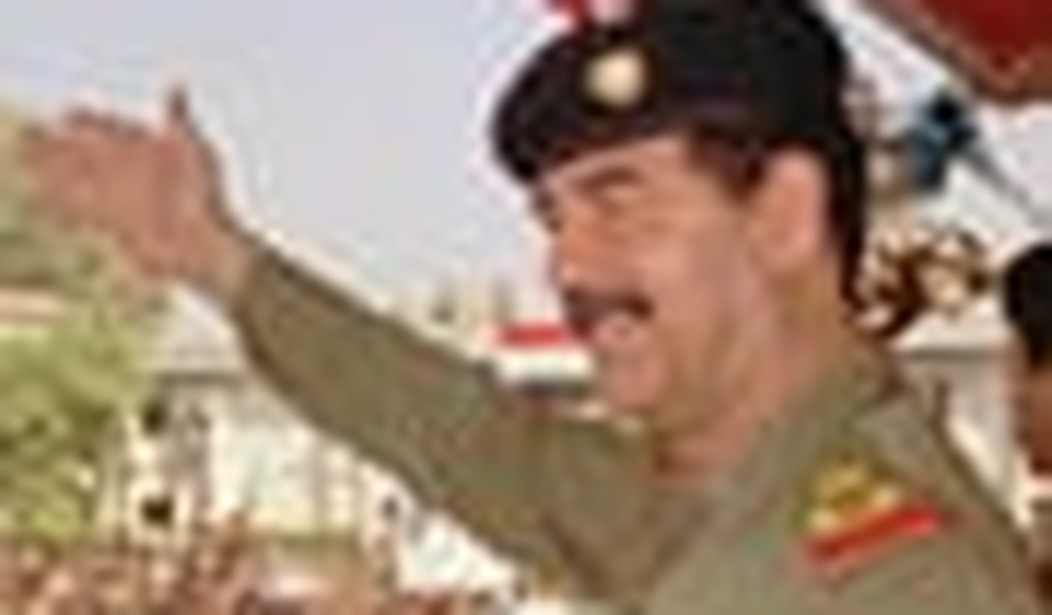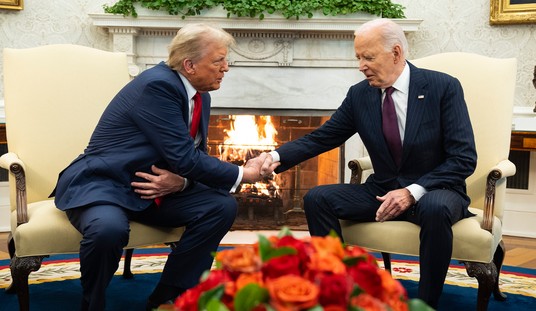“Report Shows No Link Between Saddam and al Qaeda” is how ABC News headlined their item on the Pentagon’s just-released report on the relationship between Saddam Hussein and terrorism. And John Holusha of the New York Times, who could not have read the document when he wrote this blog post because it hadn’t been made available yet, went with the slightly punchier headline: “Oh, By the Way, There Was No Al Qaeda Link.” (Holusha relied on the McClatchy newspapers to do his spadework for him).
Not that the mainstream media wish to give the impression that Saddam Hussein was “contained,” of course. Stephen Hayes of the Weekly Standard has pardoned some of this fatuous and purblind coverage by saying that it can be blamed on journalists’ having only scanned the Executive Summary of the new study, which synthesizes 600,000 captured documents on Iraqi intelligence. Yet had they done even that, what they would have found was this:
“This study found no “smoking gun” (i.e., direct connection) between Saddam’s Iraq and al Qaeda. Saddam’s interest in, and support for, non-state actors was spread across a variety of revolutionary, liberation, nationalist, and Islamic terrorist organizations. Some in the regime recognized the potential high internal and external costs of maintaining relationships with radical Islamic groups, yet they concluded that in some cases, the benefits of association outweighed the risks.”
The wording here certainly leaves room for an indirect connection between the Ba’ath and Bin Laden, and even if you suppose that was nothing for the United States to worry about, there are those Islamic terrorist organizations with proven support from Saddam.
One was Egyptian Islamic Jihad, the outfit responsible for the assassination of Anwar Sadat, led since 1991 by Ayman al-Zawahiri, Al-Qaeda’s “Number Two.” Another was the Islamic Group, headed by the “Blind Sheik” Omar Abdel-Rahman, one of the architects of the 1993 World Trade Center bombing (now serving out a life sentence in a North Carolina jail). Still another was the Islamic Movement of Kurdistan, a precursor to Ansar al-Islam, the outfit which, prior to the U.S. invasion of Iraq, fell under the command of Abu Musab al-Zarqawi, who fled to the country from Afghanistan after the toppling of the Taliban. Ansar al-Islam was soon absorbed into Zarqawi’s more expansive organization, helpfully titled Al- Qaeda in Mesopotamia.
Still we hear the conventional refrain that Al-Qaeda had no “presence” in prewar Iraq, which is like arguing that a virus did not exist until it was named by epidemiologists.
Here’s another refrain: So what? Saddam was an enemy to Iraqis and neighbors in the Middle East, but he was not a threat to Americans. We had no dog in that fight.
To quote again from the new report:
“One question remains regarding Iraq’s terrorism capability: Is there anything in the captured archives to indicate that Saddam had the will to use his terrorist capabilities directly against United States? Judging from examples of Saddam’s statements (Extract 34) before the 1991 Gulf War with the United States, the answer is yes.” [Italics in the original.]
Also substantiated by the Pentagon study is what the regime had planned for the near future before its overdue demise. As disclosed in a much-neglected Foreign Affairs essay from May/June 2006, entitled “Saddam’s Delusions: The View From the Inside“:
The Saddam Fedayeen also took part in the regime’s domestic terrorism operations and planned for attacks throughout Europe and the Middle East. In a document dated May 1999, Saddam’s older son, Uday, ordered preparations for “special operations, assassinations, and bombings, for the centers and traitor symbols in London, Iran and the self-ruled areas [Kurdistan].” Preparations for “Blessed July,” a regime-directed wave of “martyrdom” operations against targets in the West, were well under way at the time of the coalition invasion.
But wait — wasn’t Saddam “secular”? Why would he deign to make common cause with jihadists? In another important admission in the Pentagon’s latest dish ignored by the press is this assessment of the dictator’s totalitarian pragmatism:
“While it is not surprising that Saddam, one of the last of the Middle East’s revolutionary nationalists, would endeavor to support revolutionary groups, it is important to recognize that many of these nationalist groups changed in the late 1990s. Saddam viewed these groups through the eyes of a pan-Arab revolutionary, while the leaders of the growing Islamist movements viewed them as potential affiliates for their Jihad. In other words, two movements, one pan-Arab and the other pan-Islamic, were seeking and developing supporters from the same demographic pool.”
The New York Sun‘s national security reporter Eli Lake has culled other provocative tidbits:
• In the same year, Saddam ordered his intelligence service to “form a group to start hunting Americans present on Arab soil; especially Somalia.” At the time, Al- Qaeda was working with warlords against American forces there.
• Saddam’s intelligence services maintained extensive support networks for a wide range of Palestinian Arab terrorist organizations, including but not limited to Hamas. Among the other Palestinian groups Saddam supported at the time was Force 17, the private army loyal to Yasser Arafat.
And Ed Morrissey at Hot Air reminds readers: “[O]ne has to remember the purpose and structure of al-Qaeda. It is not a top-down hierarchical organization like the PLO. Rather, it serves as a framework for a web of affiliated terrorist organizations, both for funding and for inspiration. AQ’s leadership structure maintains communications and coordination with these groups, which often merge with and split into other organizations.”
Michael Weiss is the New York Editor of Pajamas Media. His blog is Snarksmith.









Join the conversation as a VIP Member